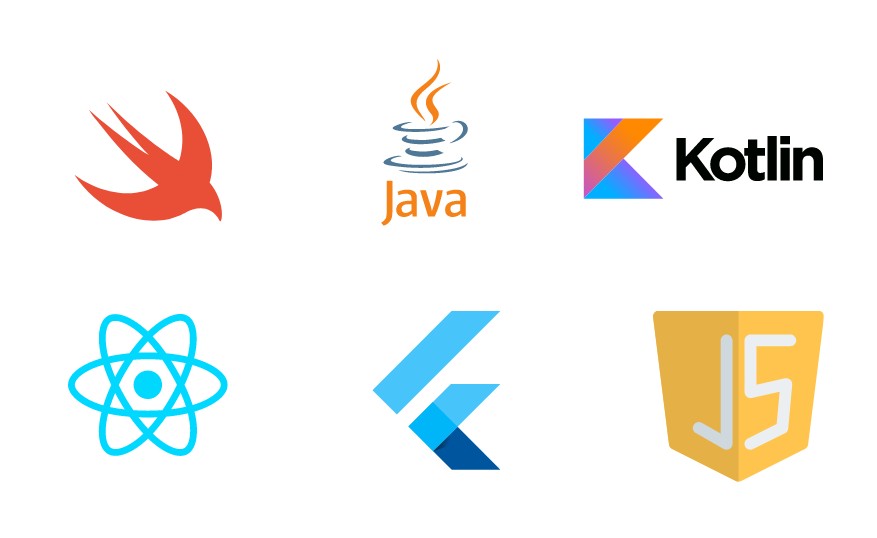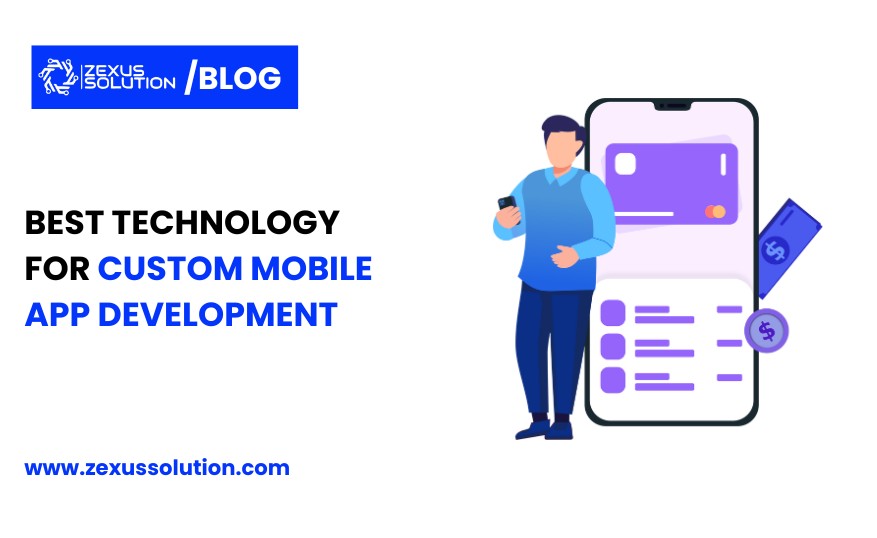Table of Contents
Today, mobile applications have become a crucial aspect of business strategy. With over 4.88 billion smartphone users worldwide as of 2024, the demand for mobile apps is at an all-time high. However, most businesses build apps using ready-to-go platforms but usually feel disappointed when they don’t fulfill their requirements.
As businesses strive to offer seamless and engaging user experiences, choosing the right technology stack for mobile app development becomes paramount. In this case, custom mobile app development can be your saviour. Opt for professional mobile app development services USA and customize your apps according to your business needs.
This blog will guide you through selecting the best technology for custom mobile app development. Let’s dig in!
Understanding the Technology Stack

Generally, a technology stack is the set of programming languages, frameworks, libraries, and tools used to build a specific software application. Regarding their roles in mobile app development, the stack can further be classified as the front-end or the client-side stack and the back-end or server-side stack.
Front-End Technologies
The front end is the part of the program that clients use. It is that portion of the application that clients can access. For mobile apps, this includes the user interface (UI) and user experience (UX) design, which are typically developed using the following technologies:
1. Native Development:
Native apps need software development for a distinct operating system (OS) by developing platform-specific languages.
- iOS: Swift, Objective-C
- Android: Kotlin, Java.
2. Cross-Platform Development
They include cross-platform frameworks, which are handy when developers want to create applications operating on various OS platforms.
- React Native: First introduced by Facebook, it uses the JavaScript programming language and employs the framework, ReactJS.
- Flutter: Created by Google, this offers Dart for development purposes.
- Xamarin: It was developed by Microsoft, and it is operational using C#.
3. Hybrid Development
A hybrid application combines various features of both native as well as web applications.
- Ionic: Utilizes Internet technologies, including HTML, CSS, and JavaScript.
- Apache Cordova: Bundles the Web applications in a native user interface.
Back-End Technologies
The back end deals with the business logic, databases, users’ credentials, and other tasks not observable to the user interface. Key components include:
1. Server
Saves client’s requests and responds to them.
- Node. js: JavaScript runtime developed based on the V8 tool from the Chrome browser.
- Django: Python-based framework.
- Ruby on Rails: As far as the implemented technology is concerned, it utilizes the Ruby-based framework.
2. Database
It physically stores and manages application data or directory data in some cases.
- SQL Databases: MySQL, PostgreSQL
- NoSQL Databases: MongoDB, Firebase
3. APIs
Promote the transfer of information between the front-end and the back-end.
- REST: Representational State Transfer
- GraphQL: Another name for the language used in API calls or requests wherein the various parameters are specified.
Popular Technology Stacks for Mobile App Development

We all know that applications offering more functionalities, like custom apps serving your specific business needs, have become more popular. Considering this, let’s discuss which technology for custom mobile app development can be helpful for your business.
Native Development
iOS (Swift/Objective-C)
iOS apps developed natively using Swift or Objective-C have better performance and fast response rates. They are also more compatible with the latest iOS APIs released and easy to synchronize with other Apple devices.
However, it involves enhanced development costs and time and is only suitable for the iOS environment. This is the best approach when developing apps that must be extremely fast and require tight integration into specific iOS frameworks.
Android (Kotlin/Java)
Creating apps natively in Android using Kotlin or Java offers a wide variety of audiences since Android has a massive market share.
The downside is the fragmentation challenges accompanying the use of different Android mobile devices and the various OS versions, which means the software must be tested and maintained comprehensively.
Cross-Platform Development
React Native
Android and iOS development is made possible through code reuse by employing React Native. This framework is backed by a powerful community and accompanied by a comprehensive library. It supports a hot reloader to make development smoother.
However, it can sometimes be slow compared to native apps, especially for large applications, and some native abilities in UA are implemented through third-party libraries.
Thus, it would be relevant for applications that must be developed and released quickly and operate on both the iOS and Android platforms.
Flutter
Flutter offers one code base for both iOS and Android. Given the nature of the Dart compiler, it provides excellent performance and the availability of numerous widgets already built in advance.
Comparatively, some disadvantages of using Flutter include that it produces apps bigger than native apps and incorporates fewer third-party libraries than React Native.
It is particularly appropriate for applications that require optimization to meet specific demands or have similar appearances across operating systems.
Hybrid Development
Ionic
Ionic uses easily recognizable web technologies such as HTML, CSS, and JavaScript. It has a vast plugin library that helps with rapid mobile application development and prototyping.
However, its performance is average compared with native and cross-platform solutions; it also has a poor capability to access native device capabilities.
Ionic is ideal for building efficient and user-friendly mobile apps, particularly those that prioritize speed to market and focus on core functionalities.
Criteria for Choosing the Right Technology Stack

Choosing the right technology for a custom mobile app development project is a challenging step that defines the app’s performance, flexibility, and success. Several aspects must be considered to ensure that the chosen technology complies with the project’s goals and necessities.
Complexity
The app’s nature and complexity influence the technology stack selection. Simple apps with basic functionalities might benefit from cross-platform frameworks like React Native or Flutter, which allow faster development and code reuse. In contrast, complex apps with heavy graphics, real-time features, or intensive processing tasks might need native development to ensure optimal performance and access to device-specific features.
Performance
Performance is critical, especially for apps requiring high responsiveness and low response time. For example, suppose an app is being developed for the Android operating system only. In that case, its performance or rendering will likely be better than that of a cross-platform or hybrid app. This can be vital for applications with much user interaction, like gaming and augmented reality apps.
Target Audience
Understanding the market share of mobile operating systems can guide your decision. As of 2024, Android holds about 70.69% of the global market share, while iOS holds about 60.77%. If your target audience predominantly uses one platform, prioritizing that platform for native development can be beneficial.
Budget
Native development can be costly in the long run because the application must be developed separately for iOS and Android. Each platform is different, meaning the skills needed for one are separate from the others. Thus, the costs of developing and maintaining these mediums are typically higher. That said, when budget is not a constraint, the advantages of utilizing native apps can far outweigh the costs.
Time-to-Market
Hybrid and cross-platform frameworks can help save time in the development process by sharing the same code with a few platforms. This is especially beneficial for startups or companies that intend to bring their apps to the market sooner rather than later. Using React Native or Flutter libraries, for instance, will enable developers to work more efficiently and deliver consistent experiences across different devices.
Team Expertise
Selecting a technology stack that the development team is familiar with proves beneficial as it involves less collision and helps generate solutions easily. If you work with a team with strong JavaScript skills, choosing React Native might be helpful for you. Meanwhile, if they are good at Swift and Kotlin, native development would mean more efficiency and better performance.
Scalability
Scalability is a critical point that should be considered when choosing a technology stack for a startup. For instance, some backend foundational tools, such as Node. js and Django are well-scalable frameworks that can easily handle many visitors. Cloud databases such as Firebase enable real-time data syncing and are scalable, making them relevant for use in apps that are likely to experience growth in users.
Maintenance
Technologies with extensive documentation, community support, and regular updates can simplify maintenance. Additionally, selecting a modular architecture can make it easier to implement updates and add new features without disrupting existing functionalities. Consider the ease of maintaining and updating the app post-launch by employing professional mobile app development services in the USA.
Conclusion
If you want a successful app, you must choose the best technology for custom mobile app development. By considering project requirements and selecting the right mobile app development services in the USA, you can make an informed choice that aligns with your business goals.
Ultimately, the right technology stack depends on your project’s requirements and strategic objectives. It is in your hands to create a custom mobile app that delivers exceptional user experiences and drives business growth by staying informed about industry trends and leveraging the strengths of various technologies.
Visit: Dyrectory.com Business Directory.



Add a Comment